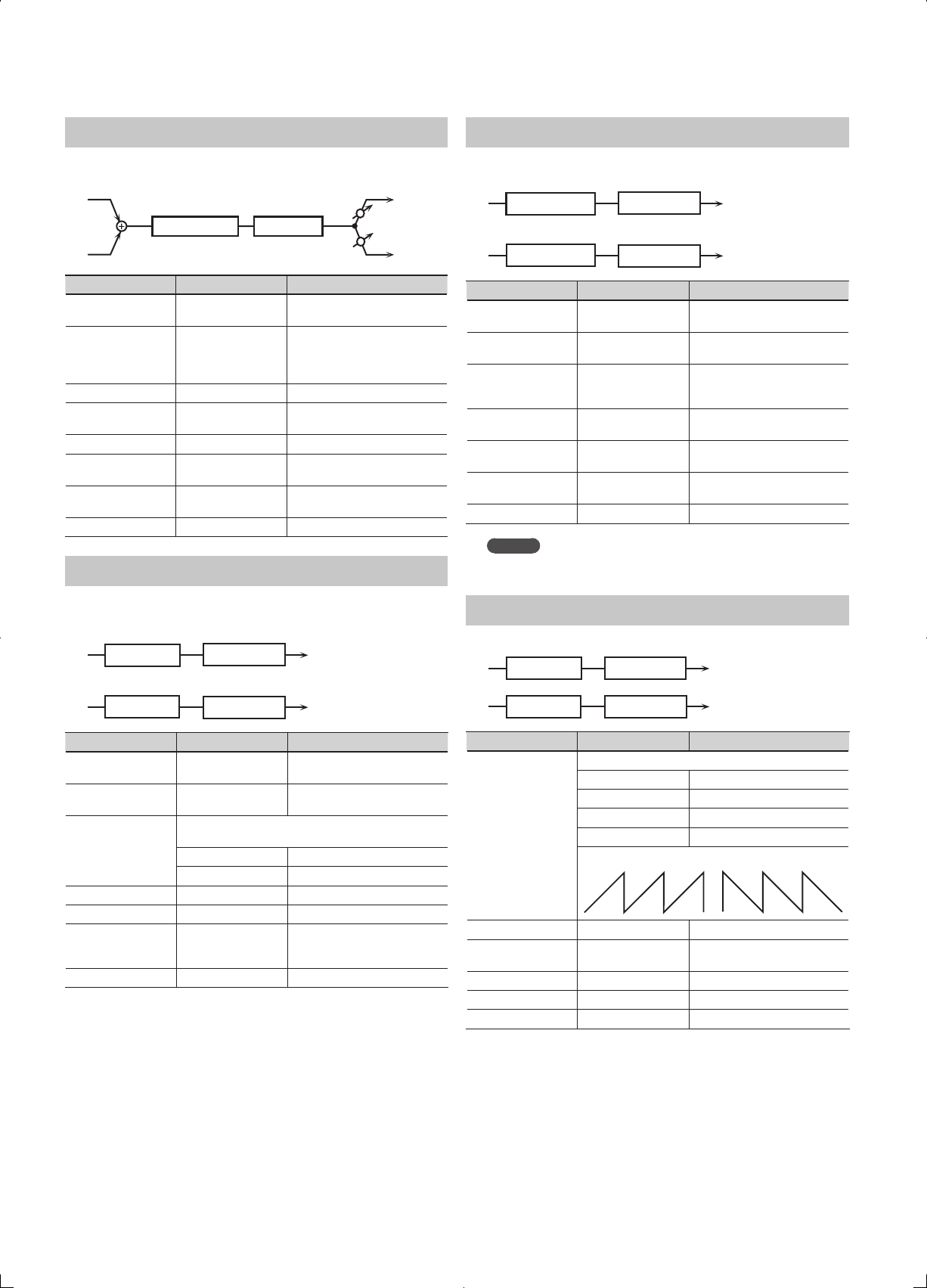
54
14: INFINITE PHASER
A phaser that continues raising/lowering the frequency at which the sound is
modulated.
Infinite Phaser 2-Band EQ
L in
R in
L out
R out
Pan R
Pan L
Parameter Value Explanation
Mode 1, 2, 3, 4
Higher values will produce a
deeper phaser eect.
Speed # -100–+100
Speed at which to raise or
lower the frequency at which the
sound is modulated (+: upward /
-: downward)
Resonance # 0–127 Amount of feedback
Mix # 0–127
Volume of the phase-shifted
sound
Pan # L64–63R Panning of the output sound
Low Gain -15–+15 dB
Amount of boost/cut for the
low-frequency range
High Gain -15–+15 dB
Amount of boost/cut for the
high-frequency range
Level 0–127 Output volume
15: RING MODULATOR
This is an eect that applies amplitude modulation (AM) to the input signal, producing
bell-like sounds. You can also change the modulation frequency in response to
changes in the volume of the sound sent into the eect.
L in
R in
L out
R out
Ring Mod
2-Band EQ
2-Band EQ
Ring Mod
Parameter Value Explanation
Frequency # 0–127
Adjusts the frequency at which
modulation is applied.
Sens # 0–127
Adjusts the amount of frequency
modulation applied.
Polarity
Determines whether the frequency modulation moves
towards higher frequencies or lower frequencies.
UP Higher frequencies
DOWN Lower frequencies
Low Gain -15–+15 dB Gain of the low frequency range
High Gain -15–+15 dB Gain of the high frequency range
Balance # D100:0W–D0:100W
Volume balance between the
direct sound (D) and the eect
sound (W)
Level 0–127 Output level
16: STEP RING MODULATOR
This is a ring modulator that uses a 16-step sequence to vary the frequency at which
modulation is applied.
L in
R in
L out
R out
Step Ring Mod
2-Band EQ
2-Band EQ
Step Ring Mod
Parameter Value Explanation
Step 01-16 0–127
Frequency of ring modulation at
each step
Rate # 0.05–10.00 Hz, note
Rate at which the 16-step
sequence will cycle
Attack # 0–127
Speed at which the modulation
frequency changes between
steps
Low Gain -15–+15 dB
Amount of boost/cut for the
low-frequency range
High Gain -15–+15 dB
Amount of boost/cut for the
high-frequency range
Balance # D100:0W–D0:100W
Volume balance of the original
sound (D) and eect sound (W)
Level 0–127 Output volume
MEMO
You can use multi-eect control to make the step sequence play again from
the beginning (p. 46).
17: TREMOLO
Cyclically modulates the volume to add tremolo eect to the sound.
L in
R in
L out
R out
Tremolo
2-Band EQ
2-Band EQ
Tremolo
Parameter Value Explanation
Mod Wave
Modulation Wave
TRI Triangle wave
SQR Square wave
SIN Sine wave
SAW1/2 Sawtooth wave
SAW1 SAW2
Rate # 0.05–10.00 Hz, note Frequency of the change
Depth # 0–127
Depth to which the eect is
applied
Low Gain -15–+15 dB Gain of the low range
High Gain -15–+15 dB Gain of the high range
Level 0–127 Output Level


















